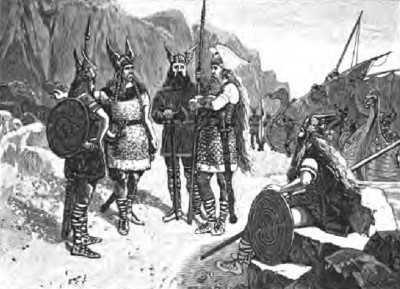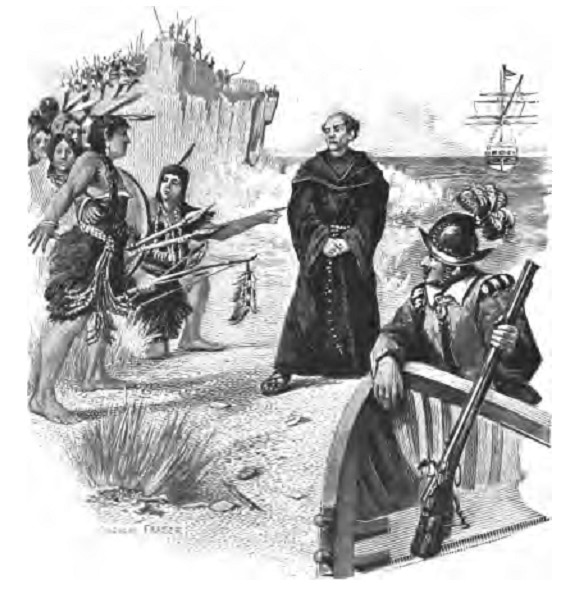| Web
and Book
design,
Copyright, Kellscraft Studio 1999-2009 (Return to Web Text-ures) |
 (HOME)
|
STORIES OF MAINE.
I. THE FIRST VOYAGERS TO MAINE. THE beginning of Maine dates back to the beginning of the great American nation. The earliest discoverers, the Northmen, who were born rovers, sailed their queer primitive ships to its shores more than a thousand years ago, and while all America was a wilderness inhabited only by Indians and wild beasts. One of these Northmen, named Biorne, sailing from Iceland to Greenland, was driven by wild winds so far astray that, as it seems from his descriptions, he caught sight of Cape Cod, and then retraced his course northeasterly along the shores of Maine and Nova Scotia. The accounts which these wandering Northmen left of their discoveries are somewhat vague and confused. Adventurers are not apt to be exact chroniclers, and stories handed down through many generations lose nothing on the way. Old Icelandic stories tell us of a Scandinavian giant, Thorhall, who would have been the discoverer of Maine if winds and waves had permitted: Wonderful were Thorhall's feats of strength, as related in these tales. When his ship got aground, he could always push it off, single-handed: when the wind fell, he rowed the ship with one mighty oar. He had even been known to pick it up and carry it across a sandbar, without troubling the crew to disembark! 
This wonderful Thorhall and his crew had sailed across Massachusetts Bay in a northeasterly direction, and almost reached the coast of Maine, when his vessel encountered a northwest wind so furious and persistent that it was blown completely across the Atlantic Ocean to the Irish shores! And in Ireland Thorhall and his men were made slaves. All that can be vouched for as true about this story is that one of the first white men to see the shores of Maine was an Icelander of unusual stature, named Thorhall. II
There is no doubt that Sebastian Cabot discovered the Maine coast, in 1498. Verrazano, a Florentine, sent by the King of France in 1524, after touching at North Carolina, sailed to the shores of Maine, and, returning, reported that he "had discovered a country never before seen by any voyager since the world began." Estevan Gomez came next, sent by Charles V. of Spain. He named the old Markland and Vinland of the Northmen, —territory of which Maine now forms a part,—the "Country of Gomez;" and he captured as many Indians as he could, to sell as slaves to the Spaniards. The Mary of Guilford, an English vessel, commanded by one John Rut, came to the coast of Maine in the year 1567. Rut and his men landed, and explored, to some extent, the interior of the country,—the first Englishmen known to have set foot upon the American continent. Andre Thevet, a French monk, was one of the earliest visitors to the coast of Maine. After he returned to France he wrote a book called "The Singularities of Antarctic France, otherwise called America;" and in it we find this description of the Penobscot River: "Here we entered a river which is one of the finest in the whole world. We call it Norumbega. It is marked on some charts as the Grand River. The natives call it Agoncy. Several beautiful rivers flow into it. Upon its banks the French formerly erected a small fort, about ten leagues from its mouth. It was called the fort of Norumbega, and was surrounded by fresh water. "Before you enter this river there appears an island, surrounded by eight small islets. These are near the country of the Green Mountains. About three leagues into the river there is an island four leagues in circumference, which the natives call Aiayascou [now Isles-borough]. It would be easy to plant on this island, and to build a fortress which would hold in check the whole surrounding country.  "Upon landing, we saw a great multitude of people, coming down upon us in such numbers that you might have supposed them to be a flight of starlings. The men came first, then the women, then the boys, then the girls. They were all clothed in the skins of wild animals. "Considering their aspect and mode of advancing, we mistrusted them, and retired on board our vessel. They, perceiving our fear, made signs of friendship. The better to assure us, they sent to our vessel several of their principal men, with presents of provisions. We returned a few trinkets of little value, with which they were highly pleased. "The next morning I, with some others, was commissioned to meet them, to see if we could obtain more provisions, of which we stood in great need. As we entered the house of the chief, who was called Pemarick, we saw several slaughtered animals hanging on the beams. "The chief gave us a hearty welcome. To show his affection, he ordered a fire to be built, on which meat and fish were placed to be roasted. Upon this some warriors came in, bringing to the chief the dissevered heads of six men whom they had taken in battle. The sight terrified us. Fearing that we might suffer in the same way, we, towards evening, secretly retired to our ship, without bidding our host good-by. "This greatly displeased him. In the morning he came to the ship with three of his children. His countenance was very sad, for he thought he had offended us. He said to me in his own language: 'Go back on land with me, my friend and brother. Come and eat and drink such as we have. We assure you upon oath, by heaven, earth, moon, and stars, that you shall not fare worse than we do ourselves.' "Seeing the good affection of this old man, twenty of us went again on land, all well armed. We went to his house, where we were feasted, and presented with whatever he possessed. "Meanwhile large numbers of his people arrived. They all greeted us in the most affectionate manner, declaring that they were our friends. Late in the evening, when we wished to retire, they all entreated us to remain through the night. But we could not be persuaded to sleep with them, and so we retired to our vessel. Having remained in this place five days, we weighed anchor, and parting from them with a marvelous contentment on both sides, went out upon the open sea." Nearly fifty years now passed away, during which no explorers visited the shores of Maine, although both France and England were sending expeditions to the New World, and trying to gain possession of the same territories. In 1602 Bartholomew Gosnold sailed from Falmouth, England, and boldly took a new route, avoiding the old circuitous one by the Azores. He stood straight across the ocean from Falmouth, and made the land about Sagadahoc. The journalist of this voyage relates that, when they anchored, they were startled by the sight of eight Indians in a Biscay shallop, with mast and sail, some of them dressed in European clothing. This happened in what is now Casco Bay, May 14, 1602. Mount Agamenticus was probably the first land seen by Gosnold, and York his first landing place. He very soon sailed away from Maine, and afterwards settled in Virginia. The next year, Martin Pring, another Englishman, entered Penobscot Bay, and probably the York and Kennebunk rivers. It is said that Pring and his men gave to the Fox Islands their name, having seen there a great number of silver foxes; also that they carried home, among other curiosities, a canoe, which was placed on exhibition, and was regarded as a marvel of ingenuity for savage tribes to have accomplished. Pring is said to have written the best description of the country that had yet been given. At about this time a little settlement was made by French priests on Mount Desert Island, and this happened as the result of a very curious quarrel. The French king, Henry of Navarre, had granted to Pierre de Monts, a Protestant gentleman and member of the king's household, a grant of all American territory lying between the fortieth and forty-sixth degrees of north latitude, that is, between the latitude of Philadelphia and a parallel a little north of Mount Katandin. M. Pourtrincourt, De Monts's friend, came with him to America, and they established the settlement of Port Royal, now Annapolis, Nova Scotia. On a second voyage to Port Royal, Pourtrincourt brought with him his son, Biencourt, and two Jesuit priests, Biard and Masse, whose purpose was to convert the natives to the Roman Catholic religion. Even before the vessel landed, Pourtrincourt had quarreled violently with the priests, declaring that it was "his part to rule them on earth, and theirs only to guide him to heaven." When he departed again to France, and left his son in command of the settlement, Biencourt was even more domineering than his father had been; for when the priests threatened him with the anathemas of the church on account of his dissipated and reckless conduct, he retaliated by vowing to set up the whipping post for them. Accounts vary as to the time that the fathers spent with Biencourt after this unpleasantness. They seem to have made an expedition to the Penobscot, and then returned to Port Royal; and it was only after being reŽnforced by other priests and some French colonists, who had come over under the patronage of Mme. de Guercheville, that they attempted the Mount Desert settlement which we shall hear of later. These Jesuit missionaries, as well as those who came after them, seem to have been truly good and self-denying men, and to have acquired a remarkable influence over the savages. In fact, it was probably through the influence of these priests that the Indians remained always on better terms with the French than with the English. |